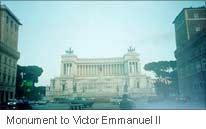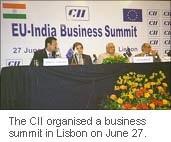Asians Ahoy!
 Rome (population = three million) is a truly
cosmopolitan (global, if you will) city. Among
the prominent immigrants are Bangladeshis and Sri
Lankans who are visible at city squares, tourist
spots and traffic junctions. They sell roses and
bouquets, work as bearers at restaurants and
clean car windscreens at traffic signals.
Rome (population = three million) is a truly
cosmopolitan (global, if you will) city. Among
the prominent immigrants are Bangladeshis and Sri
Lankans who are visible at city squares, tourist
spots and traffic junctions. They sell roses and
bouquets, work as bearers at restaurants and
clean car windscreens at traffic signals.
An evening stroll up-and-down the marketplace with its bars, restaurants, trendy leather goods, garments and fashion outlets on the ground-floor of multi-storey medieval buildings, can be enjoyable.
At traffic intersections, pedestrians are always given the chance to make the first move, unlike in India. If anyone commits the sacrilege of displaying impatience by blowing horn, he or she is promptly censured. How? Pedestrians stand in the way of the vehicle, and teasingly, animatedly give a mouthful to the guy or the girl at the wheel. All in good fun. The driver may pay back in the same coin, but the situation is always under control, no ugly scenes, no fisticuffs, no expletives.
The city buses stand out for their spacious interiors, comfort level, aerodynamic design and commuter-and-tourist friendly electronic signboards that display the route number and destination. The two-seater two-door cute Smart cars seem to be a rage.
The cafes and bars by the streets, famous for the 60s/70s night-life of stars like Sophia Loren, still buzz with activity, but one cannot detect signs of a scandal right away. But well-built, 40-plus agents of massage centres and discos and pubs zero in on tourists on the sidewalks with remarkable efficiency for word-of-mouth publicity. ("Nice massage by ladies. Very cheap," they whisper.)
Rome's original denizens take great pride in their original architecture. But their contempt for other architectural forms is baffling. Vittoriano, the monument to Victor Emmanuel II, is an imposing cream-coloured building at the foot of Capitol in the heart of Rome. Its colonnade overlooks Rome's main traffic junction. The structure was built over a number of years under the supervision of different architects. The monument is a symbol of fusion of various architectural styles. So Italians find it difficult to identify themselves with this piece of what seems splendid architecture.
Vajpayee da Gama!
 Business bigwigs, ministers, diplomats and
officials lost no opportunity to describe Vajpayee's trip to Portugal as a historic
one. "Five hundred years ago, the visionary
Portuguese explorer Vasco da Gama discovered a
sea route to India, promoted trade, and exposed
India to the world. Today, history has come full
circle. Visionary Prime Minister Vajpayee has
discovered a political route to Portugal to
promote business between India and Europe. He is
exposing Europe to great investment opportunities
in India," said Sanjiv Goenka, managing director
of RPG Enterprises and vice-chairman of the
Confederation of Indian Industry, which organised
a business seminar in Lisbon to coincide with the
PM's visit.
Business bigwigs, ministers, diplomats and
officials lost no opportunity to describe Vajpayee's trip to Portugal as a historic
one. "Five hundred years ago, the visionary
Portuguese explorer Vasco da Gama discovered a
sea route to India, promoted trade, and exposed
India to the world. Today, history has come full
circle. Visionary Prime Minister Vajpayee has
discovered a political route to Portugal to
promote business between India and Europe. He is
exposing Europe to great investment opportunities
in India," said Sanjiv Goenka, managing director
of RPG Enterprises and vice-chairman of the
Confederation of Indian Industry, which organised
a business seminar in Lisbon to coincide with the
PM's visit.
But the PM himself seemed oblivious of the publicity unleashed before and during his trip. A television journalist asked him on the Lisbon-Delhi special flight: "Then it was Vasco da Gama. Now it is Vajpayee. What is the difference?" A visibly amused Vajpayee counter-questioned: "What is the similarity?"
BACK
NEXT:
Namaste Pradhan Mantri-ji; Vignettes of Rome; Your Bharat Mahaan; Dining with a VVIP's daughter-in-law; Spotlight on Portugal; The old and the beautiful Portuguese; Youth on their toes; TV is cool; Lisbon is a party in June; Air-India to remain Air-India; How India will get UN Security Council seat; New Millennium, old communication methods; Modern Maharajas have the cake and eat it too; A joyous nation dives to depths of sorrow.
SINGLES | NEWSLINKS | BOOK SHOP | MUSIC SHOP | GIFT SHOP | HOTEL BOOKINGS
AIR/RAIL | WEATHER | MILLENNIUM | BROADBAND | E-CARDS | EDUCATION
HOMEPAGES | FREE EMAIL | CONTESTS | FEEDBACK
